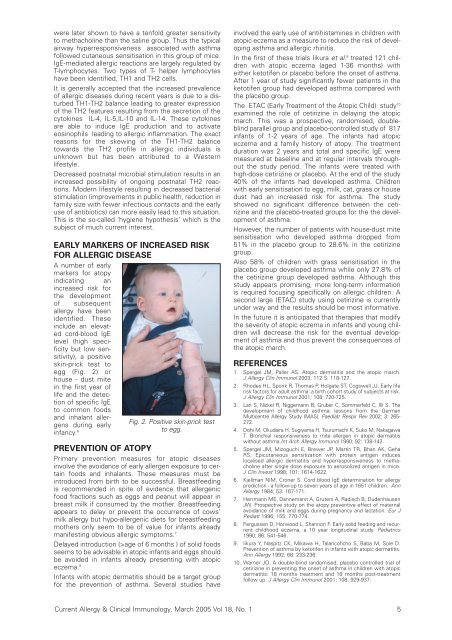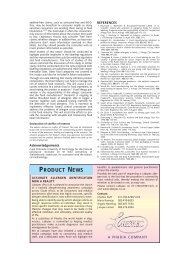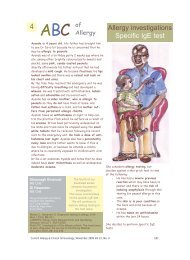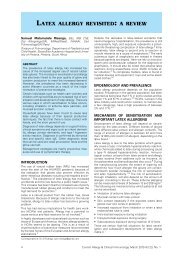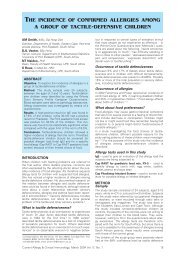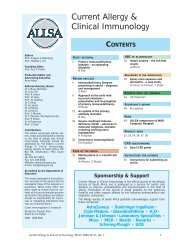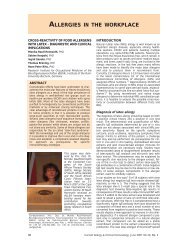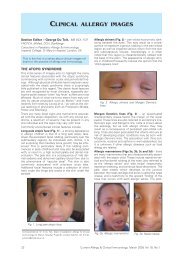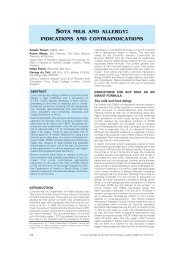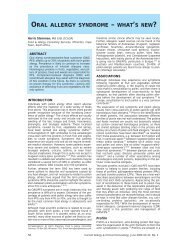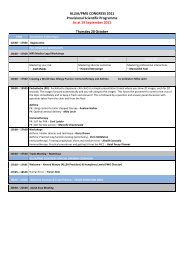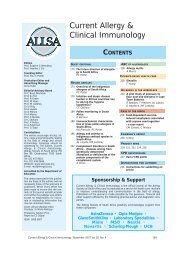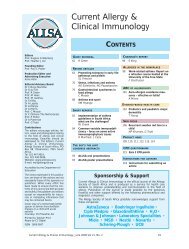The atopic march
The atopic march
The atopic march
Create successful ePaper yourself
Turn your PDF publications into a flip-book with our unique Google optimized e-Paper software.
were later shown to have a tenfold greater sensitivityto methacholine than the saline group. Thus the typicalairway hyperresponsiveness associated with asthmafollowed cutaneous sensitisation in this group of mice.IgE-mediated allergic reactions are largely regulated byT-lymphocytes. Two types of T- helper lymphocyteshave been identified, TH1 and TH2 cells.It is generally accepted that the increased prevalenceof allergic diseases during recent years is due to a disturbedTH1-TH2 balance leading to greater expressionof the TH2 features resulting from the secretion of thecytokines IL-4, IL-5,IL-10 and IL-14. <strong>The</strong>se cytokinesare able to induce IgE production and to activateeosinophils leading to allergic inflammation. <strong>The</strong> exactreasons for the skewing of the TH1-TH2 balancetowards the TH2 profile in allergic individuals isunknown but has been attributed to a Westernlifestyle.Decreased postnatal microbial stimulation results in anincreased possibility of ongoing postnatal TH2 reactions.Modern lifestyle resulting in decreased bacterialstimulation (improvements in public health, reduction infamily size with fewer infectious contacts and the earlyuse of antibiotics) can more easily lead to this situation.This is the so-called ‘hygiene hypothesis’ which is thesubject of much current interest.EARLY MARKERS OF INCREASED RISKFOR ALLERGIC DISEASEA number of earlymarkers for atopyindicating anincreased risk forthe developmentof subsequentallergy have beenidentified. <strong>The</strong>seinclude an elevatedcord-blood IgElevel (high specificitybut low sensitivity),a positiveskin-prick test toegg (Fig. 2) orhouse - dust mitein the first year oflife and the detectionof specific IgEto common foodsand inhalant allergensduring earlyinfancy. 6Fig. 2. Positive skin-prick testto egg.PREVENTION OF ATOPYPrimary prevention measures for <strong>atopic</strong> diseasesinvolve the avoidance of early allergen exposure to certainfoods and inhalants. <strong>The</strong>se measures must beintroduced from birth to be successful. Breastfeedingis recommended in spite of evidence that allergenicfood fractions such as eggs and peanut will appear inbreast milk if consumed by the mother. Breastfeedingappears to delay or prevent the occurrence of cows’milk allergy but hypo-allergenic diets for breastfeedingmothers only seem to be of value for infants alreadymanifesting obvious allergic symptoms. 7Delayed introduction (>age of 6 months ) of solid foodsseems to be advisable in <strong>atopic</strong> infants and eggs shouldbe avoided in infants already presenting with <strong>atopic</strong>eczema. 8Infants with <strong>atopic</strong> dermatitis should be a target groupfor the prevention of asthma. Several studies haveinvolved the early use of antihistamines in children with<strong>atopic</strong> eczema as a measure to reduce the risk of developingasthma and allergic rhinitis.In the first of these trials Iikura et al. 9 treated 121 childrenwith <strong>atopic</strong> eczema (aged 1-36 months) witheither ketotifen or placebo before the onset of asthma.After 1 year of study significantly fewer patients in theketotifen group had developed asthma compared withthe placebo group.<strong>The</strong> ETAC (Early Treatment of the Atopic Child) study 10examined the role of cetirizine in delaying the <strong>atopic</strong><strong>march</strong>. This was a prospective, randomised, doubleblindparallel group and placebo-controlled study of 817infants of 1-2 years of age. <strong>The</strong> infants had <strong>atopic</strong>eczema and a family history of atopy. <strong>The</strong> treatmentduration was 2 years and total and specific IgE weremeasured at baseline and at regular intervals throughoutthe study period. <strong>The</strong> infants were treated withhigh-dose cetirizine or placebo. At the end of the study40% of the infants had developed asthma. Childrenwith early sensitisation to egg, milk, cat, grass or housedust had an increased risk for asthma. <strong>The</strong> studyshowed no significant difference between the cetirizineand the placebo-treated groups for the the developmentof asthma.However, the number of patients with house-dust mitesensitisation who developed asthma dropped from51% in the placebo group to 28.6% in the cetirizinegroup.Also 58% of children with grass sensitisation in theplacebo group developed asthma while only 27.8% ofthe cetirizine group developed asthma. Although thisstudy appears promising, more long-term informationis required focusing specifically on allergic children. Asecond large (ETAC) study using cetirizine is currentlyunder way and the results should be most informative.In the future it is anticipated that therapies that modifythe severity of <strong>atopic</strong> eczema in infants and young childrenwill decrease the risk for the eventual developmentof asthma and thus prevent the consequences ofthe <strong>atopic</strong> <strong>march</strong>.REFERENCES1. Spergel JM, Paller AS. Atopic dermatitis and the <strong>atopic</strong> <strong>march</strong>.J Allergy Clin Immunol 2003; 112 S: 118-127.2. Rhodes HL, Sporik R, Thomas P, Holgate ST, Cogswell JJ. Early liferisk factors for adult asthma: a birth cohort study of subjects at risk.J Allergy Clin Immunol 2001; 108: 720-725.3. Lan S, Nickel R, Niggemann B, Gruber C, Sommerfeld C, Illi S. <strong>The</strong>development of childhood asthma: lessons from the GermanMulticentre Allergy Study (MAS). Paediatr Respir Rev 2002; 3: 265-272.4. Dohi M, Okudaira H, Sugiyama H, Tsurumachi K, Suko M, NakagawaT. Bronchial responsiveness to mite allergen in <strong>atopic</strong> dermatitiswithout asthma.Int Arch Allergy Immunol 1990; 92: 138-142.5. Spergel JM, Mizoguchi E, Brewer JP, Martin TR, Bhan AK, GehaRS. Epicutaneous sensitization with protein antigen induceslocalised allergic dermatitis and hyperresponsiveness to methacholineafter single dose exposure to aerosolized antigen in mice.J Clin Invest 1998; 101: 1614-1622.6. Kjellman NIM, Croner S. Cord blood IgE determination for allergyprediction - a follow-up to seven years of age in 1651 children. AnnAllergy 1984; 53: 167-171.7. Herrmann ME, Dannemann A, Gruters A, Radisch B, DudenhausenJW. Prospective study on the atopy preventive effect of maternalavoidance of milk and eggs during pregnancy and lactation. Eur JPediatr 1996; 155: 770-774.8. Fergussen D, Horwood L, Shannon F. Early solid feeding and recurrentchildhood eczema, a 10 year longitudinal study. Pediatrics1990; 86: 541-546.9. Iikura Y, Naspitz CK, Mikawa H, Talaricoficho S, Baba M, Sole D.Prevention of asthma by ketotifen in infants with <strong>atopic</strong> dermatitis.Ann Allergy 1992; 68: 233-236.10. Warner JO. A double-blind randomised, placebo controlled trial ofcetirizine in preventing the onset of asthma in children with <strong>atopic</strong>dermatitis: 18 months treatment and 18 months post-treatmentfollow up. J Allergy Clin Immunol 2001; 108; 929-937.Current Allergy & Clinical Immunology, March 2005 Vol 18, No. 1 5


